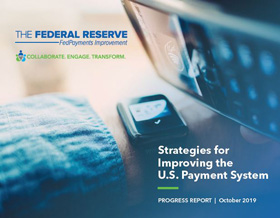It’s been nearly five years since the Federal Reserve published the Strategies for Improving the U.S. Payment System (SIPS) paper, a seminal work in guiding the nation’s payment industry toward a faster, safer and more efficient payment system in the United States. A lot has happened in those five short years, and our progress in the most recent period is no exception.
 In our role as an industry leader and catalyst, the Federal Reserve remains focused on industry collaboration. It has always been clear that a single entity cannot tackle payments improvement alone. Our payment system is simply too complex and too diffuse. We’re proud of our collaboration with industry – through task forces, work groups, speaking roles, expert panels, meetings and other engagements – and we’re encouraged by the progress toward the shared desired outcomes.
In our role as an industry leader and catalyst, the Federal Reserve remains focused on industry collaboration. It has always been clear that a single entity cannot tackle payments improvement alone. Our payment system is simply too complex and too diffuse. We’re proud of our collaboration with industry – through task forces, work groups, speaking roles, expert panels, meetings and other engagements – and we’re encouraged by the progress toward the shared desired outcomes.
Our new Fall 2019 Progress Report (PDF) summarizes the most recent payments improvement accomplishments. In the report, you’ll find updates on all of our strategic focus areas. Highlights include:
- Faster Payments. “We’re now seeing [the Faster Payments Task Force’s] vision take shape,” said the Fed’s Connie Theien in describing this year’s “historic milestones” in faster payments, including the Federal Reserve Board of Governors’ decision to develop and operate the FedNowSM Service. Theien reiterated the importance of “the spirit of collaboration and an unwavering commitment to modernizing the U.S. payment system” in achieving this progress.
- Payments Security. The Fed and its Fraud Definitions Work Group released a draft of a recommended Fraud Classification Model for Payments, in addition to publishing two papers on synthetic identity fraud in the U.S. payment system. “We’re getting very positive external feedback… and looking forward to additional dialogue,” said the Fed’s Ken Montgomery.
- Payments Efficiency. “Electronic invoicing is a critical step toward improving business-to-business payment efficiency,” explained the Fed’s Guy Berg. To support this goal, the Fed participated in the Business Payments Coalition assessment of both the e-delivery network specifications and e-invoice data standards incorporated in existing e-invoice frameworks in other countries.
For a detailed summary of accomplishments, additional commentary from Fed leaders and an outlook for the work ahead, read the full Progress Report (PDF).
To stay informed about the Fed’s progress toward improving the U.S. payment system and receive the latest news and perspectives, join the growing FedPayments Improvement Community.
